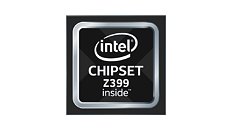- Joined
- Oct 9, 2007
- Messages
- 47,538 (7.46/day)
- Location
- Hyderabad, India
| System Name | RBMK-1000 |
|---|---|
| Processor | AMD Ryzen 7 5700G |
| Motherboard | ASUS ROG Strix B450-E Gaming |
| Cooling | DeepCool Gammax L240 V2 |
| Memory | 2x 8GB G.Skill Sniper X |
| Video Card(s) | Palit GeForce RTX 2080 SUPER GameRock |
| Storage | Western Digital Black NVMe 512GB |
| Display(s) | BenQ 1440p 60 Hz 27-inch |
| Case | Corsair Carbide 100R |
| Audio Device(s) | ASUS SupremeFX S1220A |
| Power Supply | Cooler Master MWE Gold 650W |
| Mouse | ASUS ROG Strix Impact |
| Keyboard | Gamdias Hermes E2 |
| Software | Windows 11 Pro |
Intel could very soon fork its high-end desktop platform into two, with the introduction of the new Z399 socket LGA2066 chipset later this quarter; and the fabled X599 chipset powering LGA3647 processors. The move is probably triggered by AMD's introduction of new 24-core and 32-core Ryzen Threadripper processors that wipe out competitiveness of its existing "Basin Falls" X299 platform. The X599 could essentially be a C629 with the addition of some client-segment features (and the subtraction of some enterprise-segment ones), whereas the Z399 is a whole different beast.
With the introduction X599 and LGA3647, Intel could restore competitiveness at the >$1,500 market segment with new 24-core, 26-core, and 28-core "Skylake-X" XCC (extended/extreme core count) processors; whereas the introduction of Z399 could be necessitated with a that of a new 22-core chip for the LGA2066 socket, from which Intel can carve out new 20-core and 22-core SKUs. Existing Skylake-X LCC and HCC chips could be forwards-compatible with Z399, and X299 motherboards could still be eligible for supporting new 20-core and 22-core processors via BIOS updates. The Z399 could introduce a handful of new client-segment features Intel is introducing with the Z390.

Since the LGA2066 platform won't be "extreme" anymore as that distinction gets reserved for LGA3647, the "X" in the chipset name gets replaced by "Z." This could also help consumers tell Intel's platform apart from AMD X399, which powers two generations of Ryzen Threadripper processors. Intel could hence use Z399 and the new 22-core die to compete with 2nd generation Threadripper X-series processors, while the X599 and 28-core processor could deal with Threadripper WX-series.
View at TechPowerUp Main Site
With the introduction X599 and LGA3647, Intel could restore competitiveness at the >$1,500 market segment with new 24-core, 26-core, and 28-core "Skylake-X" XCC (extended/extreme core count) processors; whereas the introduction of Z399 could be necessitated with a that of a new 22-core chip for the LGA2066 socket, from which Intel can carve out new 20-core and 22-core SKUs. Existing Skylake-X LCC and HCC chips could be forwards-compatible with Z399, and X299 motherboards could still be eligible for supporting new 20-core and 22-core processors via BIOS updates. The Z399 could introduce a handful of new client-segment features Intel is introducing with the Z390.

Since the LGA2066 platform won't be "extreme" anymore as that distinction gets reserved for LGA3647, the "X" in the chipset name gets replaced by "Z." This could also help consumers tell Intel's platform apart from AMD X399, which powers two generations of Ryzen Threadripper processors. Intel could hence use Z399 and the new 22-core die to compete with 2nd generation Threadripper X-series processors, while the X599 and 28-core processor could deal with Threadripper WX-series.
View at TechPowerUp Main Site






